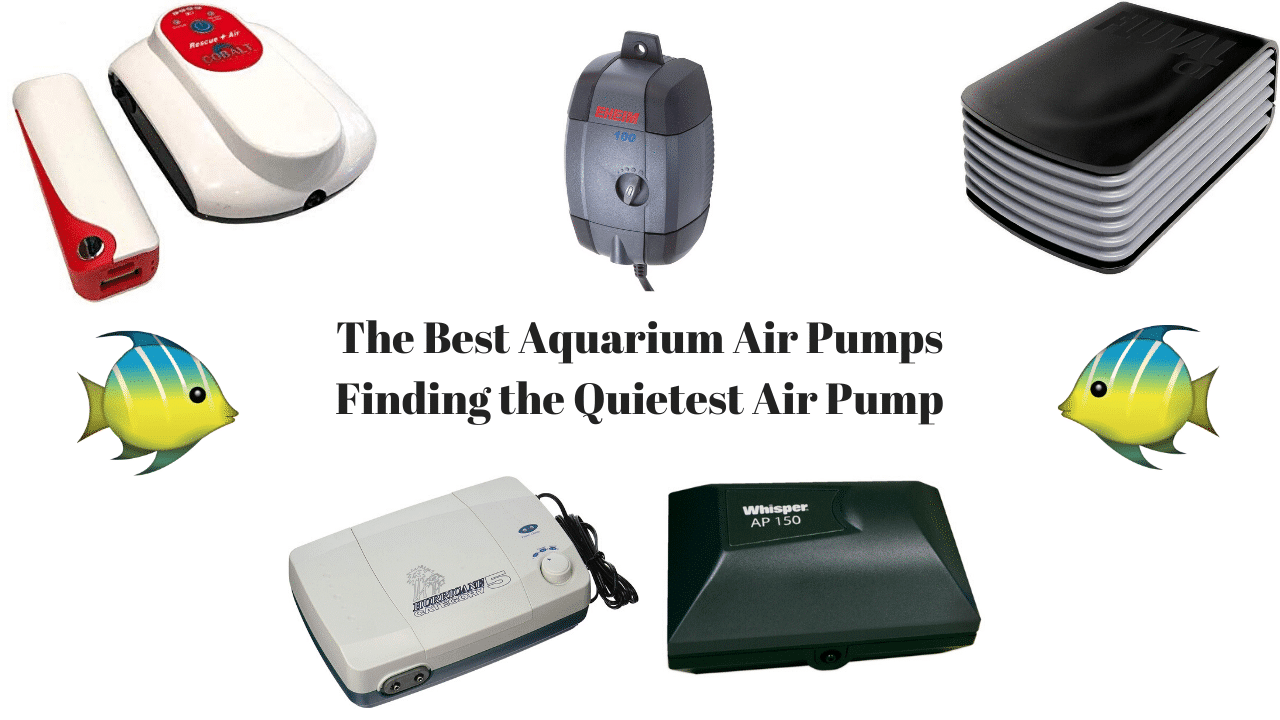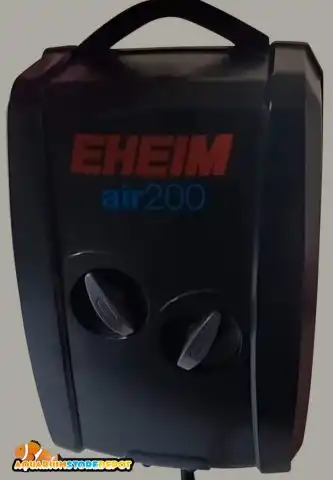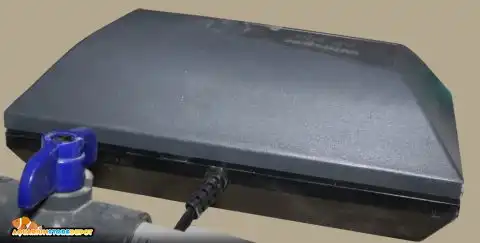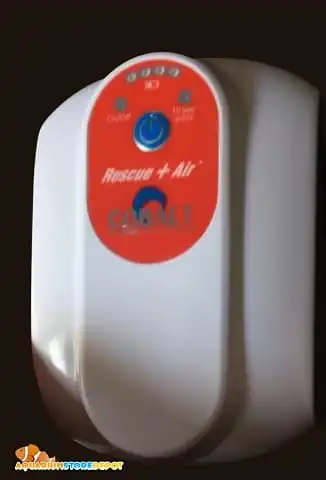Thank you for visiting! By the way… any links on this page that lead to products on Amazon and other stores/partners are affiliate links Aquarium Store Depot earns a commission if you make a purchase.
Are you struggling with finding a quiet aquarium air pump?
In this blog, we share the best aquarium air pumps, from small sized ones to ones meant for larger setups.
With over 25 years of experience in the aquarium hobby, I’ve assisted countless clients, hobbyists, and readers like you in finding quality equipment that works. I’ve personally tested these products in real world scenarios to determine the quietest and highest quality air pumps on the market.
The Top Picks
For those of you in a hurry, let’s get to the top picks right away. First off, if you want the best quality and the quietest out there the Eheim Air is a clear choice. This is the quiet air pump on the market and the Eheim brand is well known for last forever. The best value would be the M series by Fluval. It’s as cheap as lesser brands and still has the Fluval name behind it. It’s also pretty powerful for its size. Lastly, the tetra whisper is the go to for budget air pump. It has good features for the price and very easy to find even in chain pet stores.
The Candidates – A Quick Overview
There are many types of Air Pumps available today, but what is the best out there? The following air pumps have been reviewed with durability, function, and quiet operation in mind. There were many air pumps that did not make the cut. There were several that we cut from this list because we have field experience with these. The ones that I dropped are too loud, very expensive, or not very reliable. Below are the air pumps I would recommend.
| Picture | Name | Features | Link |
|---|---|---|---|
Editor’s Choice 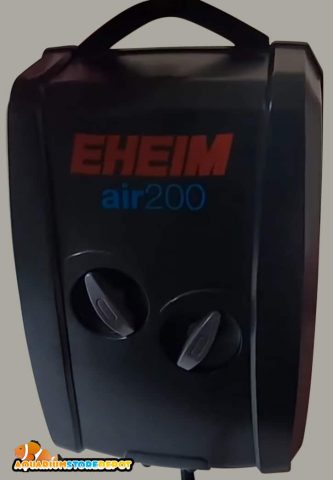 | Eheim Air Pump |
| Click For Best PriceBuy On Amazon |
Best Value  | Fluval Q Series |
| Buy On ChewyBuy On Amazon |
Budget Option  | Tetra Whisper |
| Buy On PetcoBuy On Amazon |
 | Tetra Whisper AP Series |
| Buy On ChewyBuy On Amazon |
 | Cobalt Rescue |
| Click For Best PriceBuy On Amazon |
 | Penn Plax Silent |
| Buy On ChewyBuy On Amazon |
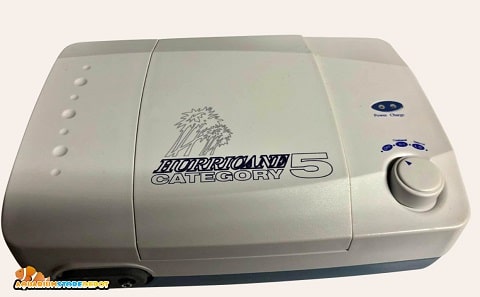 | Deep Blue Professional Hurricane Category 5 |
| Buy On Amazon |
The 7 Best Aquarium Air Pumps Reviewed
Let’s dive deep and see why these made the list!
1. Eheim
The Quietest Air Pump
Powerful, quiet, and German engineered. Even comes with an air stone! The best aquarium air pump you can buy today!
The Eheim Air Pumps are without a doubt the quietest aquarium air pumps you can buy on the market today. They are powerful, quiet, and well-made. After all, Eheim is well known for producing excellent aquarium equipment for the hobby. The other great thing about this air pump is the diffuser that it comes with is pretty good. This eliminates the guesswork of having to buy an air stone. They also give you a check valve in the box. It is a well-engineered and well-thought-out package.
It is a plug-in-only air pump. This means if you want an air pump with backup abilities you will need need to shop for another unit. You could also buy a separate battery-powered air pump. The Eheim pump is on the pricey side among the plug-in air pumps on the list.
Pros
- The quietest aquarium air pump on the list
- Eheim brand name
- Comes with a great diffuser and check valve
Cons
- Expense
- Plug-in option only
2. Fluval Q Series – Great Bang for the Buck
Best Value
Great value for a stellar brand name. The Fluval air pump delivers quality and value
The Fluval Q Series Air Pumps offer an entry-level price with the brand name we love in Fluval. Fluval, as they have always done, backs up their equipment with a generous 2-year warranty on this air pump model. For a brand name air pump, it has a get price point and should definitely be a consideration over cheaper Chinese-made units out there. It is a powerful unit with dual air outlets.
Due to the unit’s power, it does give off more noise than I would like. The sound level is more equal to lesser brand names. This is disappointing for a Fluval branded air pump. But given they are designed for larger tank capacities, it may be worth looking at if noise isn’t a concern for you. The price point for a brand name air pump is great.
Pros
- Cheap for a brand name air pump
- Fluval brand name
- Powerful
Cons
- Surprisingly loud given the brand name
3. Tetra Whisper – Great All-Around Unit
Budget Option
A well priced and solid air pump. Unique shape gives it a cool factor
The Tetra Whisper Air Pump is a staple in our industry. Tetra and their name brand Whisper have been what they are known for. The air pump is their major item in the Whisper lineup. The Tetra Whisper has a good balance of features. It is very cheap compared to the others on this list and it is quiet. It also doesn’t look that bad in your cabinet or hanging outside of your tank due to its unique shape. I guess you could say there is a bit of a cool feature with its not boxy look.
It is cheap and gets the job done. If you are looking for value, the Tetra Whisper is for you!
Pros
- Cheap
- Good balance of features
Cons
- Not as quiet as the premium brand models
4. Tetra Whisper AP – For Large Tanks
A great air pump option for larger tanks. The AP series is Tetra's best product among all its offerings
The Tetra AP Series Air Pumps are pumps designed for larger tanks. This is Tetra’s best product in the Aquarium trade. It is super quiet for how powerful it is. It is not as quiet as the Ehiem air pump. But, it is close and operates at much larger aquarium capacities — up to 300 gallons in fact. Even with its large operating capacity, it still retails at a great price. To top it all off, Tetra backs this air pump with a limited lifetime guarantee. What isn’t there to like here?
Pros
- Quiet for a large air pump
- Value Priced
- Limited lifetime guarantee
Cons
- AP 150 only has one airline hose outlet
5. Cobalt Rescue – Great Unit With Back-up Capability
A DC Powered air pump with backup capability. Battery can operate for 24 hours after a power outage
The Cobalt Aquatics Rescue Air Pumps is our first pump on the list with backup capability. It comes with an internal battery that can power the air pump for 24 hours in the event of a power outage. Add to the fact that it can be plugged in, this unit afters a primary air pump with power outage backup. It has a good amount of power output and should suit a medium-sized fish tank.
Given that it is a unit that offers a battery backup function, it is on the pricier side. It has also been reported as loud compared to some of the more quiet models that we will be looking at later. If noise isn’t that much of a concern for you and you want a power backup option, this unit would be a great pick for you.
Pros
- Backup capability with internal that lasts up to 24 hrs
- Powerful out of the box – will suit most aquariums
- Not as quiet as other models
Cons
- Expensive
- Louder than other models
6. Penn Plax Silent – A Quality Battery Powered Unit
A quality battery powered air pump. Gives 6-8 hours of run time off D batteries. A great way to protect your aquarium against power outages!
The Penn Plex Silient Air B 11 is the perfect battery-powered air pump. It has a good amount of power, being able to handle tanks up to 29 gallons. The unit is powered by 2 D batteries that should give you a life of about 6-8 hours. The auto-on feature is a nice bonus as you can plug this into your outlet and it will monitor if a power outage occurs. If an outage occurs, the battery-powered unit will turn on.
Pros
- Battery Powered
- Good power – works for up to 29 gallons
- Auto On Feature
Cons
- More expensive than other battery powered air pumps
- Loud
7. Deep Blue Professional Hurricane Category 5 – The Ultimate In Battery Powered Backup Units
The Hurricane is the ultimate in battery backup air pump technology today. Protect your prized pets with its 12 Ah battery designed to run for days
The Deep Blue Professional Hurricane Category 5 Air Pump is the ultimate in battery backup aquarium air pumps.
Pros
- Battery backup that will run for days not hours!
- Powerful
- Dual airline outlets
Cons
- Expensive
- Louder than others on the list
What Are They?
Aquarium air pumps are a piece of equipment that delivers oxygen to your aquarium. Air pumps are external devices. They need to be placed outside of your aquarium, which means they are not waterproof. The air they generate is delivered through airline tubing. You can use accessories like air stones and bubble decorations.
Air stones can distribute oxygen while bubble decorations add interest to your aquarium. They work in both freshwater and saltwater tanks. For saltwater, they tend to be used with wood stones in applications such as Protein Skimmers. Since saltwater fish tanks need to have more current than freshwater fish tanks, a wave maker is a better fit for them.

The mechanics of an aquarium air pump are actually pretty simple (image source). You have a magnet, which is the tan-colored part above that turns on and of. As the magnet turns on and off, the lever on the bottom left of the photo moves up and down. This movement from the level pumps the rubber part in the middle called the diaphragm. The diaphragm is the part that takes in air and pushes it out to the airline tubing.
Do I Need It?
The main reason to get an aquarium air pump would be to provide oxygen in the tank. The most common application for an aquarium air pump is with fish that need rich oxygen. Discus (due to higher temperatures) or Goldfish (Due to their size) are two examples. They are also great to use if you want to connect them to a Sponge Filter or Air Pump Powered Protein Skimmers.
Pumps versus Wavemakers
I do get this question a lot. Why should I get an aquarium air pump over a wavemaker? Aquarium Wavemakers are great solutions for water movement and aeration. Yet, they are not for every aquarium setup. In freshwater tanks, there are certain setups where an air pump is more appropriate. For example, fish like African Cichlids need current. Other fish like Goldfish and Betta Fish, want calmer waters. With an aquarium air pump, you can have oxygen-rich water without having a current that is too strong for fish.
Types
There are three types of air pumps in general. They are:
- Plug-in
- Battery Powered
- Battery Backup
Plug-In
This is going to be the more common air pump you come across. They plug into your outlet and run all day. Super simple and for the most part very reliable. They do not have an on and off switch and are meant to run 24-7. You can if you want to control their operation if you have a controllable power outlet.
Battery Powered
These air pumps operate off batteries. They are smaller air pumps and come in handy in the event of a power outage. The batteries tend to last a good while – usually around 8 hours. All battery-powered air pumps are unfortunately very loud. It’s simply not their main design to be quiet. They are designed to be used in a pinch. They are not designed to be your primary air pump in your aquarium. I would recommend that you have a battery-powered air pump on hand for emergencies. They will save your fish tank one day.
Battery Backup
This air pump is a combination of the two previous types of air pumps. They plug into your outlet and have a bay to place backup batteries in the unit. When the power goes out, the battery backup will kick in to keep your fish tank oxygenated. Lack of oxygen is one of the major reasons for a tank crash during a power outage. A high-end unit will likely save your aquarium one day from a power outage. They are priceless units.
Accessories – Getting the Essentials
- Airline Tubing
- Air Check Valve
- Air Control Valve
- Airstone/Bubblers
- Airline Connector
- Gang Valve
Airline Tubing

These connect your air pump to your air stone, bubble, or sponge filter The tubing transfers the airflow to your fish tank. They are very cheap to obtain and just about any you purchase will be very reliable. I would recommend Penn Plax’s Airline Tubing or Lee’s brand if shopping locally. All you do is measure and cut to length and you are good to go.
Airline Check Valve

An Airline Check Valve is an accessory that will prevent your airline tubes from siphoning water out of your aquarium. This can occur in the event of a power outage or equipment failure. They are a must for any air pump application.
Control Valve

An Air Control Valve is an accessory that allows you to have more precise control over your Air Pump’s output. They work by turning the valve to reduce or increase the airflow. For control valves, I prefer the ones made by Fluval.
Stones and Bubblers

An air stone or aquarium bubbler helps better distribute the oxygen into your aquarium. Without either, the airline connected to your air pump will generate big bubbles. These large bubbles can be loud and disruptive to your water line. In a freshwater fish tank, we prefer a smooth distribution of bubbles.
The finer the better as this provides more rich oxygen into the aquarium. Air stones are the standard that most of us in the hobby are used to and provide fine bubbles. Bubblers are more expensive than air stones and take it a step up producing a fine mist of bubbles. Air stones are cheap and get the job done, but if you want the best, go with a bubbler.
Airline Connectors

Airline Connectors are plastic pieces that allow you to split your airline in two or to connect your airline at 90-degree angles. They come in handy when you have a lot of airlines that you need to work with. Airline tubes can get bent reducing the output of your pump. The connectors will create a good directional change for you preventing the issue.
Gang Valve

A gang valve is an air pump accessory that will split your airline output into multiple lines. It also has the added benefit of being able to control the airflow of each line. It’s a combination of an air control valve and airline connectors. I would recommend Penn Plax’s Gang Valve if you are looking to get one.
How to Reduce the Noise From Your Unit
A common question I get from readers is how do I reduce the noise from my air pump. Of all the features and models I listed on this best of the post, the primary concern with an air pump is noise. The unfortunate truth is that all air pumps make a sound. There are two things we can work on here when it comes to noise:
- Quality of sound
- Reducing sound
The quality or the type of sound that your air pump produces is a major factor. A lower-quality air pump will rattle and bump while the higher-quality brands like Eheims will hum along. An air pump that hum along tends to not annoy people, even if they are louder than the ones that rattle.
Reducing the sound itself is the next thing we can work on. We can do the following to further reduce the noise produced by our air pump:
- Raise the depth of our airstones
- Moving the air pump to a different location
- Fill any unused airline outlets
Raise the Depth of Your Stones
For smaller pumps, they will work harder the deeper your air stones are placed in the tank. You can solve this by moving the air stones up or considering purchasing a larger air pump that can operate at those depths without having to work hard.
Move It To A Different Location
Air pump location is a very important factor. If they are leaning on something, they can create more vibrations that can create more noise. Even the surface it sits on could create a problem. If the surface is an issue, you can consider moving it or placing the air pump on a Neoprene Mat.
If you have an Aquarium Cabinet with doors, placing the air pump inside the cabinet can muffle the noise. Keep in mind that many budget built aquarium cabinets are made of particle board. A particle board and an air pump are a bad combination. Consider a neoprene mat to migrate the noise if you are using such a cabinet. Oak cabinets fare a lot better at noise absorption.
Fill Any Unused Airline Outlets
Some of the air pumps we have featured in this post have multiple airline outlets. This is great for having the ability to use multiple airlines out of the box, but can also create a problem if you do not utilize them. Unused airline outlets will be noisy as the air pump will push air to these outlets even if unused. To reduce the noise, one way would be to plug in airline tubing to the unused outlet. It will generate less noise than if the outlet was left open.
FAQS
Can A Unit Be Too Strong For A Fish Tank?
Yes, an air pump can be too strong for a fish tank. If they are oversized, they can disrupt the water surface too much causing stress on your livestock. It’s best to either buy a smaller air pump or split the outlets so they can be spread out to other parts of the tank.
Should I Turn It Off At Night?
No. It’s not necessary to turn off your air pump at night. However, you can if you wish to disconnect it if your air pump is not connected to your filtration system, like a sponge filter
Do Fish Like Stones and Bubblers?
Yes, but not because they actually like the way it looks. Air stones distribute air more calmly than just your airline and the added oxygen benefits your fish. So in that way, fish do like air stones in their tank.
Do I Need One If I Have A Filter?
You typically will not need an air pump if you have a capable filter. However, there are certain fish where added oxygen would benefit them like Discus fish. Air pumps also become more important if a tank is overcrowded because oxygen starts to become scarce.
Conclusion
- About the Author
- Latest Posts
I’m thrilled that you found Aquarium Store Depot! Here you’ll find information on fish, aquariums, and all things aquatics related. I’m a hobbyist (being doing this since I was 11) and here to help other hobbyists thrive with their aquariums! I adhere to a high quality Editorial Process and Review products with real life field usage and practical analysis.

